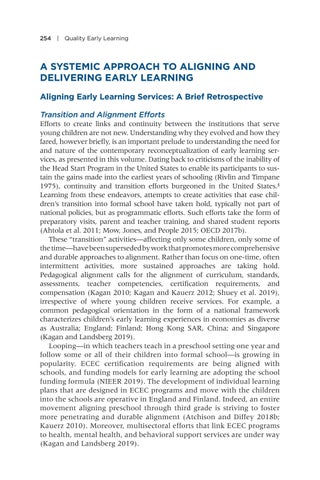254 | Quality Early Learning
A SYSTEMIC APPROACH TO ALIGNING AND DELIVERING EARLY LEARNING Aligning Early Learning Services: A Brief Retrospective Transition and Alignment Efforts Efforts to create links and continuity between the institutions that serve young children are not new. Understanding why they evolved and how they fared, however briefly, is an important prelude to understanding the need for and nature of the contemporary reconceptualization of early learning services, as presented in this volume. Dating back to criticisms of the inability of the Head Start Program in the United States to enable its participants to sustain the gains made into the earliest years of schooling (Rivlin and Timpane 1975), continuity and transition efforts burgeoned in the United States.4 Learning from these endeavors, attempts to create activities that ease children’s transition into formal school have taken hold, typically not part of national policies, but as programmatic efforts. Such efforts take the form of preparatory visits, parent and teacher training, and shared student reports (Ahtola et al. 2011; Mow, Jones, and People 2015; OECD 2017b). These “transition” activities—affecting only some children, only some of the time—have been superseded by work that promotes more comprehensive and durable approaches to alignment. Rather than focus on one-time, often intermittent activities, more sustained approaches are taking hold. Pedagogical alignment calls for the alignment of curriculum, standards, assessments, teacher competencies, certification requirements, and compensation (Kagan 2010; Kagan and Kauerz 2012; Shuey et al. 2019), irrespective of where young children receive services. For example, a common pedagogical orientation in the form of a national framework characterizes children’s early learning experiences in economies as diverse as Australia; England; Finland; Hong Kong SAR, China; and Singapore (Kagan and Landsberg 2019). Looping—in which teachers teach in a preschool setting one year and follow some or all of their children into formal school—is growing in popularity. ECEC certification requirements are being aligned with schools, and funding models for early learning are adopting the school funding formula (NIEER 2019). The development of individual learning plans that are designed in ECEC programs and move with the children into the schools are operative in England and Finland. Indeed, an entire movement aligning preschool through third grade is striving to foster more penetrating and durable alignment (Atchison and Diffey 2018b; Kauerz 2010). Moreover, multisectoral efforts that link ECEC programs to health, mental health, and behavioral support services are under way (Kagan and Landsberg 2019).




